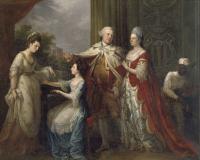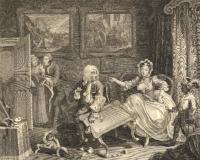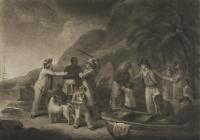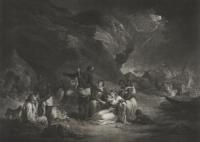The black figure in Angelica Kauffman’s earl of Ely family group portrait
Published in 18th-19th Century Social Perspectives, 18th–19th - Century History, Features, Issue 2(March/April 2012), Volume 20
The Ely family group portrait (1771). The painter, Angelica Kauffmann, was of Swiss origins. She worked in Italy before arriving in London in 1766 and became a founder member of the Royal Academy of Arts in 1768. She visited Ireland for six months in 1771—from which period the Ely group painting probably dates—and left England in 1782 for Rome, where she died in 1807. Grand, semi-official group portraiture is comparatively rare in Ireland, but Kauffman’s commissions included three such works: the Ely family group, the Townshend family group and the Tisdall family group. These works are anomalous in both Kauffman’s output and the Irish context. (National Gallery of Ireland)
Modern Ireland is becoming an increasingly multi-ethnic society, but what is known about the racial mix of earlier eras? Some answers have been provided by W.A. Hart in a ground-breaking 2002 article based largely on evidence from newspapers. But there are other forms of evidence that might also be considered. One visual source is the Ely family group, painted by Angelica Kauffman and dated 1771. It invites study not only for its large scale, careful composition, telling gestures and lively colour but also for its inclusion of a black figure, a rare occurrence in imagery of the era related to Ireland.In the Ely family group there are five figures, four of whom can be identified (from the left): Dolly Monroe and her sister, Frances; their uncle, Henry Loftus, earl of Ely; and their aunt, Frances Monroe, countess of Ely. The fifth, the enigmatic figure of the elegantly uniformed servant who bends subserviently and looks deferentially up to his mistress and master, is anonymous. He is not just a servant who is used literally to carry a reference to the elevation of Henry Loftus from viscount to earl; he is also a pictorial device and a revealing expression of eighteenth-century social history. He may have been a specific person whose identity has been lost, or he may be an example of a generic type often found in the portraiture of the period, especially that of the British school. Although he is on its periphery, the servant’s action is integral to the meaning of the painting.
Black servants bought and sold
Whether slavery was legal or not in Britain and Ireland remained a grey area despite various court cases. People of the class depicted by Kauffman, who were nominally servants, were openly bought and sold in both countries and so must be classed as slaves. Such sales are listed in the small ads of contemporary newspapers. For example, the Cork Journal of 15 March 1762 advertised:

William Hogarth’s The Harlot’s Progress, scene two (1732). Black servants, especially boys, were often treated as prized possessions and fashionable accessories, simultaneously useful and decorative, domestic but exotic, who were decked out in elaborate livery or uniforms. Note the lockable metal collar. (British Museum)
‘To be sold for account of D.F. a black negro boy aged about 14 years, remarkably free from vice and a very handy willing servant’.
Other ads listed purchasers’ specific requirements, as in Williamson’s Liverpool Advertiser of 29 April 1756:
‘Wanted immediately, a black boy. He must be of a deep black complexion, and a lively, humane disposition, with good features, and not above 15, nor under 12 years of age.’
According to the beliefs of the time, the darker an individual’s colour the more exotic they were deemed to be, and therefore the more expensive. The dark skin and facial features of the Elys’ servant seem to be African or West Indian but may be read as those of subcontinental India. Precise geographical origin did not always matter; what did matter was that the origin was remote and mysterious. Kauffman’s inclusion of a black figure, the only one to be seen in her extensive output, raises a number of questions to do with the black figure in art and in society.
Black servants could be an allusion in portraits to overseas trading interests, as is seen in William Hogarth’s Wollaston family. A black figure could also be a pictorial contrast to rows of white faces. Black servants, especially boys, were often treated as prized possessions and fashionable accessories, simultaneously useful and decorative, domestic but exotic, who were decked out in elaborate livery or uniforms. They were valued aesthetically for their exoticism and usually protected and treated well so as to safeguard their financial value, although on reaching adulthood males were sometimes thrown out and returned to slavery in the West Indies. They were human commodities in an age that indulged its appetites for the colours, tastes and textures of the world beyond Europe, the expanding world of imperial possession.
‘Silver padlocks for blacks and dogs’
The slave status of many black figures, especially boys, is evident from a small but commonly found detail in paintings and prints, the lockable metal collar. This can be seen in works throughout the century, such as The family of Sir William Young, a group portrait of c. 1766–70 by Johann Zoffany (Walker Art Gallery, Liverpool), or in the second scene of Hogarth’s well-known satirical series The Harlot’s Progress (1732). In the London Advertiser in 1756 the metalworker Matthew Dyer advertised ‘silver padlocks for blacks and dogs; collars etc.’ Like dog collars, the slave collars were engraved with the name and address of the owner and might also include the offer of a reward for the return of the slave if lost—or, more likely, absconded. Kauffman’s figure seems to be free of this gruesome object, although in the group by Zoffany it can clearly be seen, so the practice certainly continued until the time the Ely group was painted. In Kauffman’s painting the servant’s status can easily be inferred from his position, which is socially and compositionally marginal.But did the Ely family have a black servant? The records are silent on this, but it is a possibility, given that other Irish peers of the period certainly did. For example, a black servant to the earl of Granard was recognised as a freeholder and therefore allowed to vote in the parliamentary election in 1783. What visual representations were made of black people in eighteenth-century Ireland? A painting by Thomas Roberts, who is better known for his landscapes, is one. It has been identified as a work exhibited by Roberts at the Society of Artists in Ireland in 1772 as Portrait of bold Sir William (a Barb), an East Indian black, and a French dog, in the possession of Gerald Fitzgerald Esq. It has sometimes been treated as a portrait of Tony Small (see sidebar), most recently by Stella Tillyard in her biography of Lord Edward. This, however, is unlikely.
Hart mentioned a North African visitor to Dublin in 1783, a merchant called or known as Ahmet Ben Ali. He was enrolled as an honorary member of the Dublin Volunteers and had his portrait painted in miniature by Horace Hone and engraved in Walker’s Hibernian Magazine. But examples such as these are few and far between—there are very few eighteenth-century portraits of identifiable black people.

Anti-slavery sympathisers could purchase a pair of calculatedly contrasting prints after paintings by George Morland: Execrable human traffic, or, The slave trade
Black presence in Ireland
Hart estimated the black population in Ireland at 1,000 to 3,000 over the period 1750–99. References to black people related mainly to port locations—Dublin, Cork, Waterford, Belfast and Kinsale—but references are also found to a black presence in less predictable locations well inland, such as Athlone, Longford, Enniskillen and Carrickmacross. Black people played varied social roles, from slaves and servants on the one hand to musicians, many in regimental bands, and apothecaries’ apprentices on the other. A comparatively well-documented individual is the singer Rachael Baptist, who was born in Ireland and enjoyed a successful career the length and breadth of the island from at least 1750 to the mid-1770s, appearing at venues from Cork and Bandon to Belfast.Intermarriage with the local population was accepted and commented on positively; those who objected publicly were quickly denounced. Free black people were generally well integrated and accepted into society; there seems to have been little working-class racial prejudice, and ordinary folk would rarely inform on escaped slaves. The Belfast Newsletter, 5–8 September 1786, was one of many journals to reject the long-standing claim that had always been part of the justification for slavery, that black people were inferior to white people. This statement appeared when the anti-slavery movement was gathering momentum—the formal campaign by the Society for the Abolition of Slavery was launched in 1787.
Slave trade

African hospitality, both published in 1791. (British Museum)
Slavery may have been practised in Ireland only to a limited extent, but Irish merchants and sailors were certainly participants in the slave trade or in the trade in products produced by or for slaves. The abolitionist movement had quite some support in Ireland, however, especially in Belfast and Dublin. This took various cultural as well as social and political forms. For example, anti-slavery sympathisers could purchase a pair of calculatedly contrasting prints after paintings by George Morland, Execrable human traffic, or, The slave trade and African hospitality, published in 1791. Ireland was the enthusiastic host in 1791–2 of the former slave and abolitionist Olaudah Equiano, the title of whose autobiography, The interesting narrative (1789), is a masterpiece of understatement. This work appeared in a Dublin edition in 1791, selling an impressive 1,900 copies. The list of subscribers to that edition was headed by the archbishop of Dublin and included the lord mayor, Henry Howson, the earls of Ormond and Milltown, the duke of Leinster, David La Touche and Lady Moira, but no members of the Ely family.The black servant figure could only have been included by Kauffman with the consent of her patron, Lord Ely, who may even have suggested it. The presence of a black servant figure in portraits had been an established artistic convention since the seventeenth century. Therefore, if not a demand of the patron, the black servant in the Ely group may have been a gesture by Kauffman to show that she had, after five or so years in Britain, learnt what were the prevailing elements in group portraiture, which she then applied to Irish sitters. Kauffman had been around long enough in the art world to know that the capacity for innovative variation on an established and popular theme was much admired and was appraised as a form of professional distinction. HI
Philip McEvansoneya is a lecturer in the history of art at Trinity College, Dublin.
Further reading:
D. Dabydeen, Hogarth’s blacks: images of blacks in eighteenth-century English art (Manchester, 1987).W.A. Hart, ‘Africans in eighteenth-century Ireland’, Irish Historical Studies 33 (129) (May 2002).W.W. Roworth (ed.), Angelica Kauffman: a Continental artist in Georgian England (London, 1992).
The author thanks Adrian Le Harivel, Síghle Bhreathnach-Lynch and Brendan Rooney for their help in preparing this article, which is based on a paper read at the symposium ‘The Ely Family Explored’, held at the National Gallery of Ireland, 14 October 2005.
















